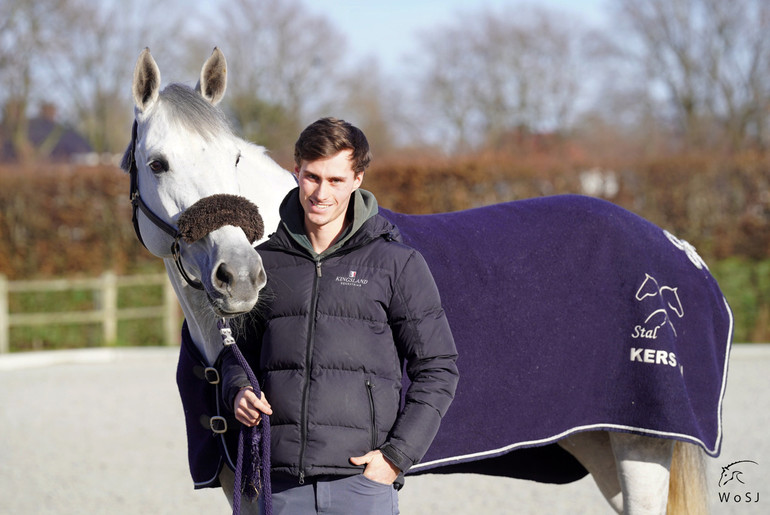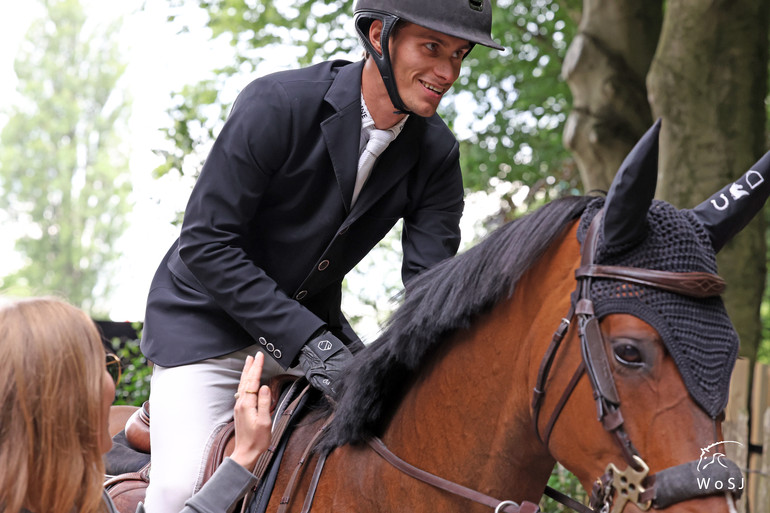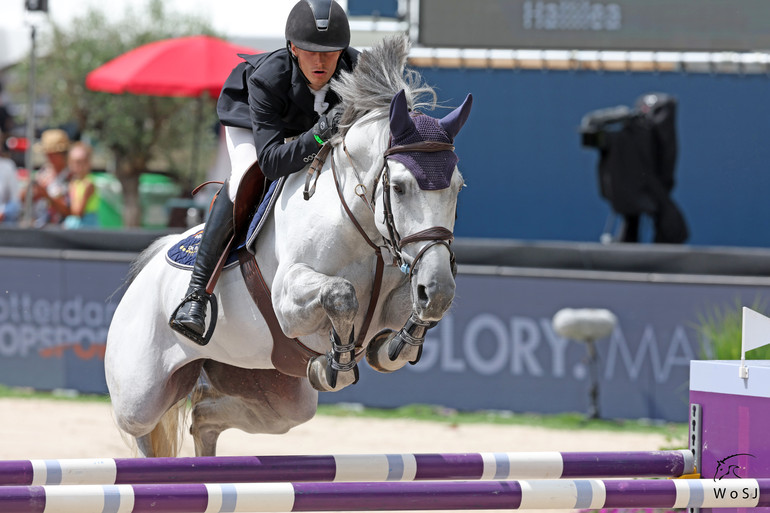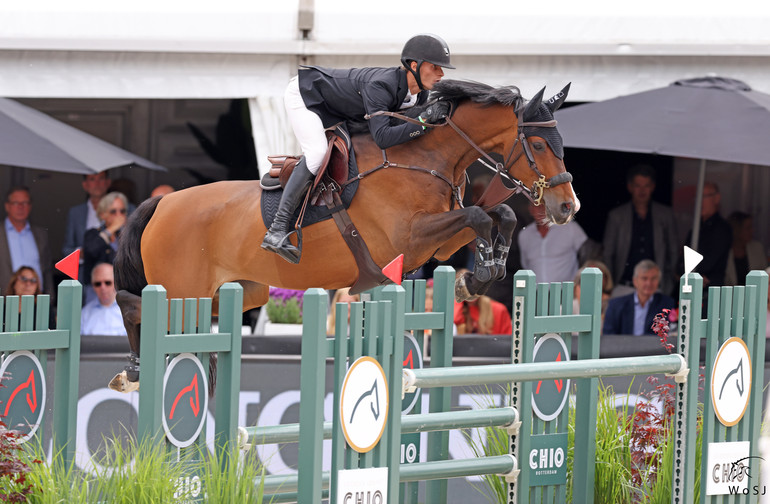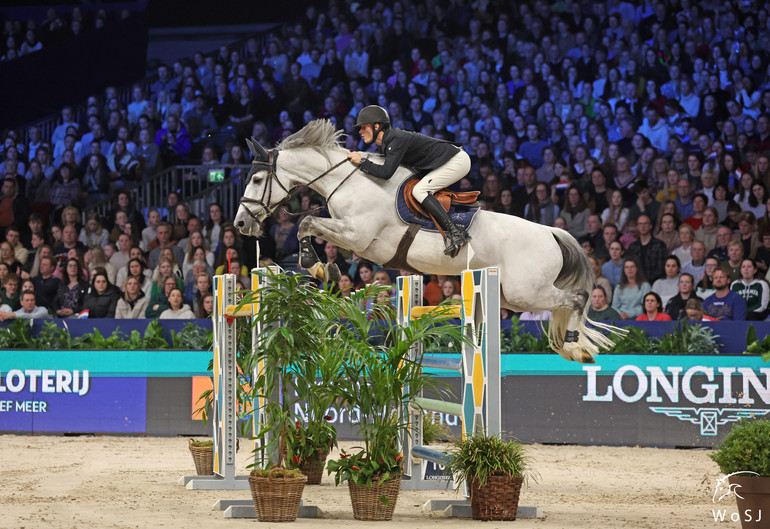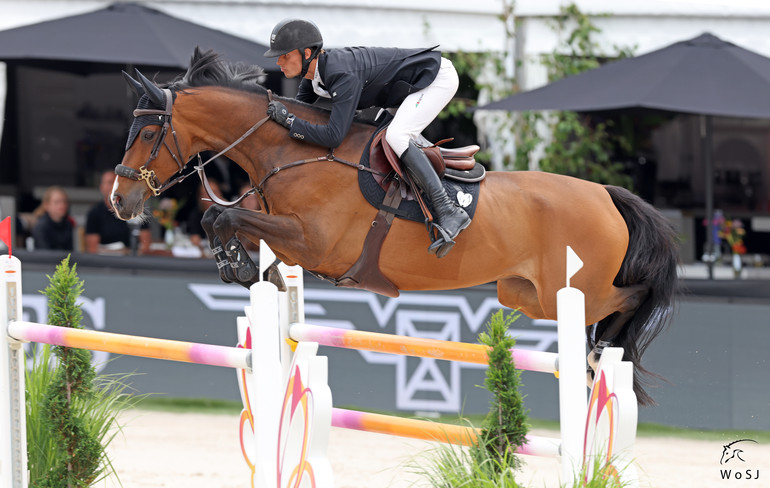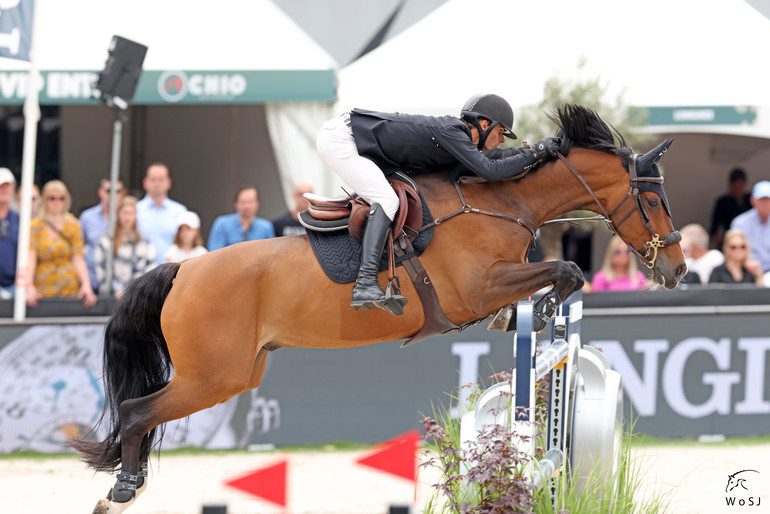Text © World of Showjumping
“I am happy to see that I am not just a name on the start list; I can actually be competitive. It has been a nice realization to have,” 23-year-old Lars Kersten says after good results in the 2022/2023 Longines FEI Jumping World Cup Western European League. The Dutch rider is currently ranked 23rd, having picked up points in four out of his five appearances in the league this season – the top eighteen will be qualified for the final in Omaha, USA, in April. The fact that the 2022-season was Kersten’s first step up to test himself at five-star level, makes his results even more remarkable. World of Showjumping met Kersten – currently ranked 144th in the world – at home in Egchel, the Netherlands.
“If we really go to the basics, just working with the horses is what I enjoy the most in this sport,” Lars tells. “Every horse has a different character, and as a rider you have to find the right way to go about it. I really like to get to know the horses and feel what works best for each of them. I think it is good to have your own system, but I always try to adapt to each horse, because they are all individuals. And in the end, if that leads to a good result, that is the nice part of the sport; you work hard, you interact a lot with the horses and then in the end, you might win.”
Family fun
When Lars and his twin brother Niels were four, their parents Pieter and Bernice moved to Egchel, where they have built a beautiful farm with space for 35 horses. “My dad started as a dressage rider and later switched to jumping, and he did both disciplines on Grand Prix level,” Lars explains. “My brother Niels and I started with ponies, just playing around, and around the age of seven we began to compete. As the years passed by, we moved quite early on to horses, and I think that has been a benefit for both for us. Riding got more and more serious, and then we started to do international shows – we did the whole thing, from ponies to children, to juniors and then to young riders, to the championships.”
We always went to the shows with an old truck and a camper behind it
“Until seven years ago, we did everything together,” Lars tells. “Then Niels went to work for Otto Becker, where he was for three years, before he moved on to Darragh Kenny for a short period of time. For the last three years, he has worked for Leon Thijssen. Even though I have been based at home during the time Niels has been away, and mainly been trained by my dad, I have also been going for short trainings with Marcus Ehning, Otto Becker and Jos Lansink. In the end, what they have told me has always been what my dad has already said to me – but sometimes you need to hear it from someone else as well,” he smiles.
“Now that I have made the step up to five-star level, the whole operation has grown so much that it is actually time for Niels to come home and for us to work together again,” Lars tells. “Me and my brother are very close, and if there is a problem, we call each other – we speak about our rounds and our horses. We have a very good relationship; we want to make each other better.”
It's what’s on the truck that matters
“Growing up, when we were riding ponies, and later on in the youth classes, we always went to the shows with an old truck and a camper behind it,” Lars recalls about the beginning of his riding career. “I remember how Niels and I would be watching the other riders our age and their fancy trucks. However, our dad always told us: “It only matters what is on the truck, and how you ride” – and I think that is true. Many of those we used to compete against back then, are no longer in the sport. My dad’s words have stayed with me though, it was a good lesson: What matters is what is on the inside. Top riders didn’t get to where they are because they had a fancy truck – they got to where they are because of the knowledge they built up, and the work they did. Wealthy or not, in this sport it is more about your attitude.”
It only matters what is on the truck, and how you ride
“Obviously, money makes everything easier because our sport is expensive – those are just facts. But it only makes it easier for the horse people who are already the horse people that they are,” Lars continues. “I think the base that makes a good rider is the desire to work on yourself – even if you have talent, you have to take the time and put in the work – and knowledge. And of course, you need the right horses – which often is the financial part of the story. But there are so many aspects that in the end separate the top from the rest.”
“You can feel the decrease in real horse people, and I think it is partly about the change of generation,” Lars says. “I want to see myself as someone who grew up with horses, as someone from a true horse-family – that is the only thing I hope we can keep, the real horsemanship.”
SHL Farms
Last year, with the support from SHL Farms, Lars got a string of horses that were able to jump on five-star level. “Previously, I had some really nice horses, and I did seven European Championships in the youth divisions, winning team gold in 2019 as well as individual bronze,” he tells. “However, after that I had kind of a gap year, where a few horses left. When you want to get better, those moments can feel frustrating, since we in our sport rely on the horses; you need a good horse to be able to compete on the highest level. Getting these horses from SHL Farms really fast-tracked my career. In a matter of months, I got the opportunity to jump in Rotterdam – where we were double clear in the Grand Prix – and from there on it just started rolling; I got into other five-star shows, as well as on the senior Nations Cup team.”
In this sport it is more about your attitude
“At the moment, I have five horses from Sarah Ryan’s SHL Farms,” Lars tells about his current string of horses. “I got the ride on these horses at the beginning of last summer, and before our five-star debut in Rotterdam, I had been riding them for about two months. Rotterdam was my first really big show with them. Emmerton (Silvio I x BMC Sam R) is my first horse, he did the Nations Cups last summer, while Quatinka (FRH Quaid x Perigueux) has stepped up to do a few 1.60m courses too. We also have a few younger ones, that all jump from 1.40m to 1.60m level, and then I have a group of our own horses, including Hallilea (VDL Zirocco Blue x Larome), who we have bred ourselves. She has really stepped up now and did the World Cups in Leipzig and Amsterdam. We breed a little bit, between four to six foals every year. That works nice for us. It is so expensive to buy the good horses ready; we believe in trying to breed them ourselves – and so far, we have been quite lucky.”
Hallilea
“I have been riding Hallilea since she was five,” Lars tells about his grey mare that finished 12th in the World Cup in Leipzig. “I have been working her up from a young horse to what she is today, which is nice for our family – for sure my dad is a proud breeder and owner. However, to be fair, I would not have expected her to be jumping at the level that she is jumping now. She was always very careful, and her mentality was super, but I think it is really hard to tell with the young ones. Maybe one or two exceptional horses will give you the feeling from the first moment you sit on them that they have the ability to jump anything. However, with some horses, they just have to grow into it a bit more – and if you stay quiet and let them develop at their own pace, they can end up being amazing. This has been the case with Hallilea; I always knew she had what it takes for 1.50m level, the question was more about if she could make that final step to the highest level. Only recently, I got the chance to jump her as my first horse at a five-star show – the first time she stepped up was in Mechelen, where she won and she has given me the feeling that it is easy for her.”
Pathfinders and patience
“I just try to focus on myself and my horses, and make sure we are in the best shape possible, to get the best results out of these opportunities,” Lars tells about his calm approach to stepping into the five-star circuit. “Obviously, you might get a bit extra excitement, and you are a bit sharper, but for me it is not that I get nervous at a big show. I was really thrilled to ride in Rotterdam, and to jump double clear in my five-star debut on home soil was really cool. I have done some three- and four-star shows, but to make the step up to five-star level, you need a really good horse. For me, that horse has been Emmerton; he really brought me to that level and made it possible for me to ride a big Grand Prix and jump a Nations Cup. He will always be a special horse for me because of this, and I will always remain very grateful for SHL Farms for giving me these opportunities. As a rider, you really need a pathfinder like Emmerton, and after, there will be other horses that can follow. Like now with Hallilea, to have Emmerton has helped her as well – she has been able to gather experience alongside him. At one point, she can make the next step, but you always need that one horse to break through and get you in there.”
You have to be able to cope with failure and stay patient
“You must have a lot of patience,” Lars continues to speak about the long journey to the highest level of the sport. “Like many others, I have experienced that owners bring their horses elsewhere or that the horses get sold. At the end of the day, this is our living, so we do have to sell every now and then – that is a part of the sport. It is something that can feel like a setback, but I think it is important to stay patient, keep working on yourself and keep working on the horses you have. As a rider, you have to be lucky to get a chance, but you cannot get too upset when you face a setback or lose a horse; you have to shake it off and think forward. In our sport, you get many setbacks, and you have to be able to deal with that. Even if you look at the best riders in the sport, they all had some down times – so you have to be able to cope with failure and stay patient.”
“At the moment, I am in a nice flow, but for sure there will be times where I might not have the right horses; so much can happen,” Lars points out. “When things go wrong, it is important to stay calm and go back to the basics. In our sport, everyone cannot be clear every day! I think what separates the good riders from the rest is that they see the difficult moments as opportunities to improve; you cannot let yourself be defeated after a bad result.”
I think what separates the good riders from the rest is that they see the difficult moments as opportunities to improve
“Last year, I got to experience the high level and I loved it,” Lars says when asked about his long-term goals. “I would like to do that for the years to come, but I also understand that there will be times where it might not be possible. However, my goals include trying to do the sport on the highest level while also focus on our stable at home. My brother Niels is coming back home, and it is a big goal for both of us to make a successful business here. We already have a beautiful place, but there is always something to improve and things we can do better. Our stable at home is very important for us, but both of us also hope to be in the sport. Our parents are still very involved; my mum does the administration and the finances, and my dad is in the stable and teaches a lot. When Niels comes home, they will take a step back – not over night, but they can slowly start taking it a bit easier.”
The bigger picture
“It is difficult to explain our sport to someone outside of it, because you need to have a passion for it to really understand the emotions involved,” Lars says about the future of the sport and the current discussion revolving around the social license to operate. “The base of our sport is the interaction with the horses, and that for me is already something really special. Working with these incredible animals and building a connection with them, working with them towards something, to make them and ourselves better – is what makes our sport so unique in so many ways.”
“I think it is really important for the whole equestrian community to really reflect on how the general public perceives our sport – and to really think about how we as riders handle ourselves,” Lars points out. “As an example, if your horse stops, you should not pick a fight – it doesn’t help; not yourself and for sure not the sport as a whole. As riders, we really have to be aware to never take anything out on the horse. Even the little details concerning the choices of bits and boots, people react to it; we have to be aware of how our choices are received. With social media, it is all so much more out there than it ever was – even just five years ago. I think we really have to be aware of this issue and take it seriously. Another important point to keep in mind is that we have to have decent judges who understand what they see. In my opinion, strict rules can only be a positive thing for the sport. Whatever is better for our horses and the sport as a whole, is something to consider.”
13.2.2023 No reproduction of any of the content in this article will be accepted without a written permission, all rights reserved © World of Showjumping.com. If copyright violations occur, a penalty fee will apply.



